Roller Skiing - equipment
The
following text will support all who are interested in roller skiing how are
looking for the right equipment:
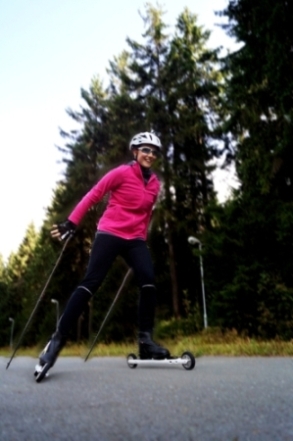
Roller skiing Technique
Skating or classic?
Before you decide which roller ski you want you should choose your riding
technique, whether skating or classic. Please desist from choosing a
combination roller ski. The various techniques of roller skiing place special
demands on the equipment of each technique. A roller ski for skating should be a little bit "unstable" to ensure a
lateral impression (possibility to tilt them to the side while doing the kick). But a classical one must be tip-resistant to create a
straight impression in running direction (the classic wheels are much wider than skate wheels). Looking at it from this aspect you realize
that for each running technique you need a special type of roller ski.
The roller ski
Frame material?
Frame construction?
Tires?
Roller ski brake?
The roller ski grows to a high-tech sports product. Manufacturer offer many
different types of classic- or skating roller ski. Athletes can choose for
example between standard frames, lowered frames and frames made out of aluminum,
carbon fiber or wood connections.
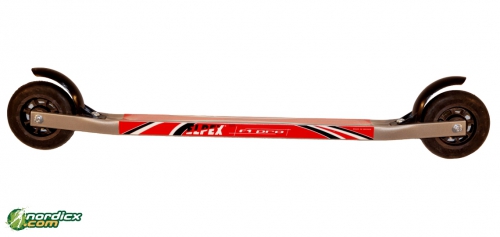 A good flex of roller ski frames allows the bending of the frame at peak times (e.g. while
impact) and returning to its original state. The frame imitates a feeling like
doing cross-country skiing. Roller ski with a good flex feel almost like a
driving experience in cross country and is ideal for summer training in
cross-country skiing.
A good flex of roller ski frames allows the bending of the frame at peak times (e.g. while
impact) and returning to its original state. The frame imitates a feeling like
doing cross-country skiing. Roller ski with a good flex feel almost like a
driving experience in cross country and is ideal for summer training in
cross-country skiing.
Moreover, the market offers additional to the different frame materials two
different constructions of the frame for roller ski. These are standard frames and lowered
frame (frame surface is slightly below the axis point of the tires). Standard
frames are usually cheaper, trough their higher center of gravity but something
unstable. Lowered roller ski frames have a lower center of gravity stable but they are
usually a little more expensive.
For beginners, the choice of a roller ski with aluminum frame is recommended because
they can get first impressions of roller skiing for a small price. Advantageous
are lowered frames. Advanced skiers and skiers who use the roller ski for
summer training should take frames made out of carbon. The frame should be
selected according to your own preferences.
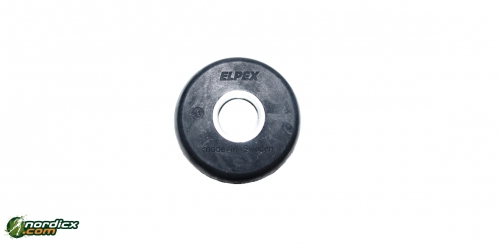
Every skier should know that fast roller ski wheels concerning no high trainings
effect and poles are less necessary with running speed.
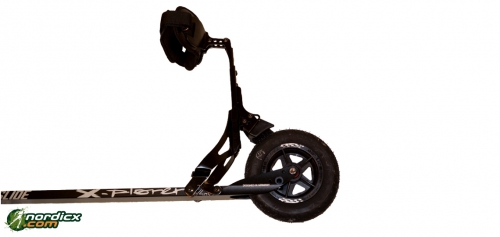 Manufacturers, such as Powerslide, offer special roller ski brakes for theire own models. In
general you should note that driving with roller ski on the road is prohibited.
Opportunities are offered in special areas for roller skiing. We offer a roller ski brake which fits on nearly all roller skis.
Manufacturers, such as Powerslide, offer special roller ski brakes for theire own models. In
general you should note that driving with roller ski on the road is prohibited.
Opportunities are offered in special areas for roller skiing. We offer a roller ski brake which fits on nearly all roller skis.
Binding
Compatible with shoes (NNN or SNS)?
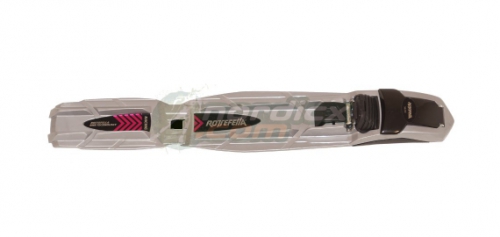 Bindings of a roller ski are the same known from cross-country skiing. Please note that
your bindings should match to your shoes, because there are two types of
bindings existing at the market like the Salomon SNS system and Rottefella NNN
system. Both systems require different bindings!
Bindings of a roller ski are the same known from cross-country skiing. Please note that
your bindings should match to your shoes, because there are two types of
bindings existing at the market like the Salomon SNS system and Rottefella NNN
system. Both systems require different bindings!
You should also select the binding for your roller ski after the running technique - whether
skating or classic. For cross-roller ski skating bindings are generally
recommended, because the ski binding provides a better handling cause of a
harder flex of the binding-rubber.
Shoes
Compatible with binding (NNN or SNS)?
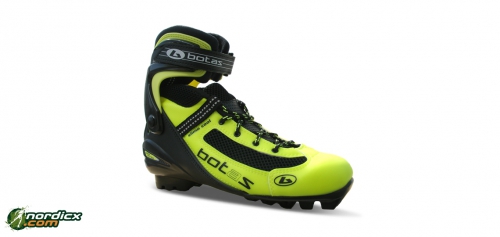 For roller skiing you can use cross country skiing shoes. For athletes in the south countries or who do roller skiing only we offer special rollerski boots for summer using. The offer a better air-circulation and keep your feet "fresh". Beginners should
start with skating shoes because of a better and more stable handling. For the
professionals we recommend the use of classical or skating shoes for each
technique. Attention should also be given to the compatibility with the binding
(SNS or NNN binding system).
For roller skiing you can use cross country skiing shoes. For athletes in the south countries or who do roller skiing only we offer special rollerski boots for summer using. The offer a better air-circulation and keep your feet "fresh". Beginners should
start with skating shoes because of a better and more stable handling. For the
professionals we recommend the use of classical or skating shoes for each
technique. Attention should also be given to the compatibility with the binding
(SNS or NNN binding system).
Poles
Classic or Skating? -> Right size?
Take into consideration that roller ski skating poles should be longer than poles for
classical technique.
To select the correct size for skating poles take a look at this formula:
Size (in cm) x 0.91 (x 0.92 for cross/offroad) = roller ski pole skating (in cm)
Classic roller ski poles should be calculated with this formula:
Size (in cm) x 0.86 (x 0.92 for cross/offroad) = roller ski pole classic (in cm)
In general, at an intermediate size should be rounded up or down to the next
pole size.
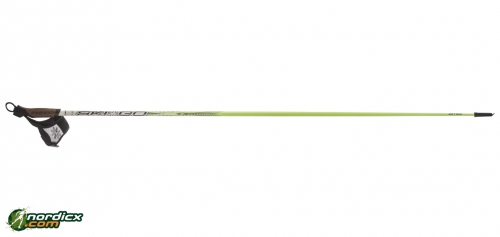 Skiers who do both (classic and skating) need two different poles. Alternatively
telescope poles can be used because you can change their size and you only need
one pair of poles. But they are really heavy. The market provides a variety of poles. Basically preferred are
poles with higher carbon content because on the one hand they are lighter and
on the other hand they can transfer more of your power than aluminum poles. We recommend to use roller ski poles with around 80% carbon (they are really stiff on hard ground and light as well) like the SkiGo Roller80.
Skiers who do both (classic and skating) need two different poles. Alternatively
telescope poles can be used because you can change their size and you only need
one pair of poles. But they are really heavy. The market provides a variety of poles. Basically preferred are
poles with higher carbon content because on the one hand they are lighter and
on the other hand they can transfer more of your power than aluminum poles. We recommend to use roller ski poles with around 80% carbon (they are really stiff on hard ground and light as well) like the SkiGo Roller80.
Roller ski poles have special tips that are
designed for hard asphalt. If you want to use your cross-country ski poles then
you can replace the plate with videa tips. You can upgrade to roller ski poles by
equipping xc-skiing tips as well.
Safety
Helmet?
Protectors?
Gloves?
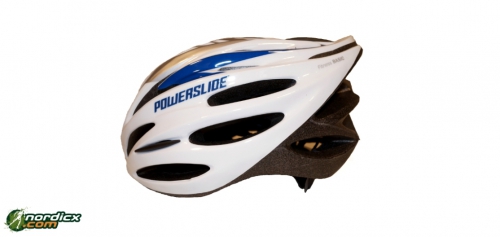 Helmless is headless! You are advised always to wear a helmet regardless
of your riding level! Usually high quality helmets have better ventilation for
tours in summer. In general, the roller ski helmet should fit well. Help for buying the
right helmet is the head circumference (in centimeters). Many helmets are
adjustable and in case of an emergency they provide better protection than no
helmet.
Helmless is headless! You are advised always to wear a helmet regardless
of your riding level! Usually high quality helmets have better ventilation for
tours in summer. In general, the roller ski helmet should fit well. Help for buying the
right helmet is the head circumference (in centimeters). Many helmets are
adjustable and in case of an emergency they provide better protection than no
helmet.
Besides a roller ski helmet, gloves should be used. They can protect against abrasion of
the skin and they provide protection from graze in the case of falling.
Protectors for elbows and knees offer additional protection.
General
Roller skiers are subjects to special risks. Please keep this in your mind every time on your ride, even if the feeling of happiness is high. A considerate dealing with yourself, the sports equipment, and especially with other people can avoid accidents and damages. Remember that roller ski are not equipped with brakes and braking must be trained! The installation of a roller ski brake is recommended. Roller skiing is prohibited on roads. Please drive only on signposted routes. Please use the off-road and cross roller ski in respect to nature and ensure the protection of nature. Different weather conditions needs a different style of skiing!








